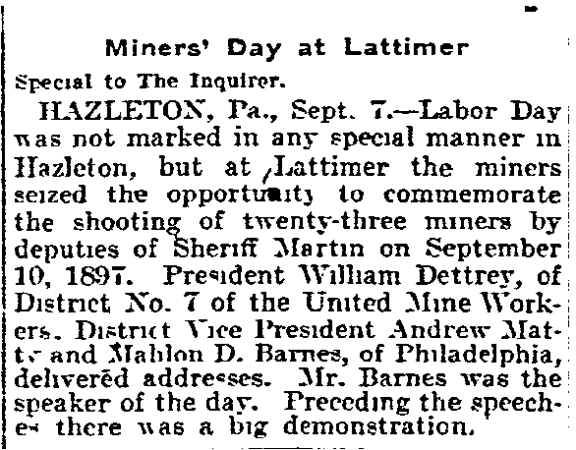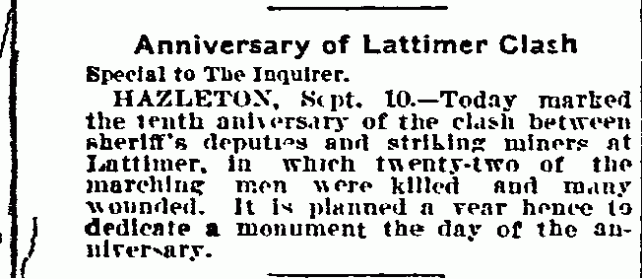Lattimer Massacre: the early history of its commemoration
September 10, 2013 2 Comments
On September 10th, 1897 19 miners were shot to death on the road and fields at the east end of Lattimer. Today mark’s its 116th anniversary. The entire event took place over about 5 to 7 minutes in the late afternoon of that day. In the days and weeks immediately afterwards, funeral processions made up of the families, community members and fellow workers of the fallen made their way across the city of Hazleton. This was the first commemoration of the fallen.
In the following decades, efforts were made to commemorate the event, and plans made to build a monument to the fallen in the city of Hazleton. This article from 1903, six years after the event, describes a Labor Day plan to commemorate “Lattimer Day” with a speech by Mother Jones addressing miner’s of the Lehigh Region:
This article, from September 8, 1903 from the Philadelphia Enquirer describes either the same event, or another one, in Lattimer, this time not mentioning Mother Jones, but prominent members of the UMWA speaking at the event, held in Lattimer. The speakers were preceded by “a big demonstration”:
At this time, plans to build a monument in the city of West Hazleton came about. Numerous articles detail the meetings and planning that went into this effort. Two lots were purchased in West Hazleton and a basic design was chosen. In 1903 $8,300 was collected into a fund by the UMWA to build the monument with extra to set aside for its maintenance. A newspaper article from the time states that:
A prominent member of the committee stated yesterday that the monument would be erected next summer without fail and would be dedicated with a big demonstration….. if a site could not be secured on the river commons one would be purchased at Lattimer and the the monument erected there. It will be an imposing shaft of granite, about twenty feet high, surmounted with a bronze figure of a miner, and will have a massive base on which will be some suitable inscription. (September 16, 1903, Wilkes-Barre-Times)
An editorial added to this article illuminates the controversy and tenderness over the monument present at the time, still only a few years after the event. The article states that members of the city council will be placed in an awkward position voting to erect the monument on public land:
If they vote for placing it on city property they will be accused of condoning the action of the rioters, while their refusal will lead to mean they approved of the shooting. There will ·be lots of opposition from motives that cannot be otherwise than honest.
The editorial goes on to state that “no monument relating to any of our national struggles grace any of our open spaces and it will hardly be acceptable to a great many people to place a local event In the front rank.” At this time it seems that the writer perceives the event as confined to only local significance. To commemorate it on open public space might overshadow the perhaps underrepresented celebration of broader national events. This somewhat cryptic article may hint at some of the controversies that kept the monument from erection for more than 70 years.
In 1907, the monument still had not been erected. There is no indication whether the event was commemorated in town in some way or another. This article cites that the plan is to have the monument set one year hence:
The eleventh anniversary came without a monument being constructed. This article from September 11, 1908 in the Philadelphia Enquirer, also states that there was no observance of the event at this time. It simply states that the plans “have not yet been completed”.
Newspapers were silent about the event and the plan to build a monument for a few years after this, though plans resurfaced again in 1911 and 1912. After this, the trail goes dry until the 75th anniversary, September 10, 1972, when the monument we know so well was erected by the United Labor Council of Lower Luzerne and Carbon Counties along with the UMWA and the AFL-CIO. In a speech given at the time of the commemoration, George Meany, president of the AFL-CIO, stated that “The things [the fallen miners] died for have not yet been achieved.”
To mark the 116th anniversary this year, a ceremony is to be held at the monument today. An interfaith service will be held at 3:30 p.m. in memory of those who lost their lives that day. Several members of the clergy in the area will participate.






